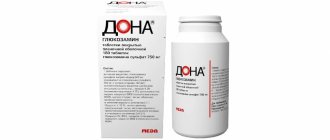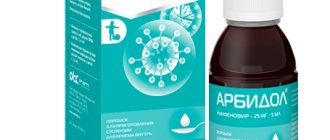Pharmacological properties
Pharmacodynamics
As a local laxative, sodium picosulfate, after bacterial breakdown in the large intestine, has a stimulating effect on the colon mucosa, increasing peristalsis, and promoting the accumulation of water and electrolytes in the large intestine. This leads to stimulation of the act of defecation. Reducing evacuation time and softening stool. The effect occurs 10-12 hours after administration.
Sodium picosulfate, being a laxative acting at the level of the colon, stimulates the natural process of evacuation of contents from the lower parts of the gastrointestinal tract. Therefore, sodium picosulfate does not affect the digestion or absorption of high-calorie foods or essential nutrients in the small intestine. The use of the drug is not accompanied by tenesmus and spasms. During a course of treatment, it stimulates the growth and metabolic activity of normal intestinal microflora.
Pharmacokinetics
After oral administration, it is not absorbed from the gastrointestinal tract and does not undergo hepatic-intestinal circulation.
Use during pregnancy and breastfeeding
There are no reliable and well-controlled studies of sodium picosulfate in pregnant women. However, long-term experience with use has not revealed a negative effect of sodium picosulfate on pregnancy. The use of sodium picosulfate in the first trimester of pregnancy is contraindicated. In the second and third trimesters of pregnancy (as with the use of other laxatives), the use of the drug is possible only as prescribed by a doctor.
The active metabolite and its glucuronides are not excreted in breast milk. Thus, the drug can be used during breastfeeding.
Indications for use
As a laxative in the following cases:
- constipation caused by atony and hypotension of the colon (including in old age, in bedridden patients, after operations, after childbirth, during breastfeeding);
- constipation caused by taking medications;
- to regulate stool in case of hemorrhoids, proctitis, anal fissures (to soften the consistency of stool);
- gallbladder diseases, irritable bowel syndrome with a predominance of constipation;
- constipation caused by intestinal dysbiosis, poor diet.
Directions for use and doses
Inside. Adults and children over 10 years of age: 10-20 drops (5-10 mg) per day. The maximum daily dose for adults and children over 10 years of age is 20 drops (10 mg). Children 4-10 years old: 5-10 drops (2.5-5 mg) per day. The maximum daily dose for children from 4 to 10 years is 10 drops (5 mg).
It is recommended to start taking it with the minimum recommended dose. In order to achieve regular bowel movements, the dose may be increased to the maximum recommended. It is not recommended to exceed the maximum recommended daily dose.
The recommended dose for children under 4 years of age is 0.25 mg/kg body weight per day. This corresponds to 1 drop of the drug (0.5 mg sodium picosulfate) per 2 kg of body weight per day.
To obtain a laxative effect in the morning, you should take the drug the night before. The drug does not have to be dissolved in liquid.
Compound
Composition per tablet
Active ingredient:
| Sodium picosulfate in terms of anhydrous substance: | 5.0 mg |
| Excipients for obtaining core tablets weighing: | 95.0 mg |
| Potato starch | 27.64 mg |
| Lactose monohydrate | 58.45 mg |
| Povidone K-25 (plasdon K-25, polyvinylpyrrolidone K-25) | 2.96 mg |
| Magnesium stearate | 0.95 mg |
| Excipients for obtaining a film-coated tablet, weight:: | 97.85 mg |
| Opadry II yellow | 2.85 mg |
| Polyvinyl alcohol | 1,140 mg |
| Talc | 0.422 mg |
| Macrogol-3350 (polyethylene glycol 3350) | 0.576 mg |
| Titanium dioxide | 0.695 mg |
| Iron oxide yellow dye | 0.017 mg |
Side effect
With short-term use of the drug, side effects are rare.
Possible side effects are classified according to frequency of occurrence as follows: very often (≥1/10), often (≥1/100 and <1/10), infrequently (≥1/1000 and <1/100), rarely (≥1/100). 10,000 and <1/1000), very rare (<1/10,000), frequency unknown (currently there are no data on the prevalence of adverse reactions).
With long-term use of the drug in significantly increased doses, the following disorders are possible:
From the skin and subcutaneous tissues
Frequency unknown: skin rash, urticaria, itching.
Metabolism and nutrition
Frequency unknown: increased excretion of potassium, sodium and other electrolytes, possible development of dehydration.
From the gastrointestinal tract
Very common: diarrhea. Common: dyspeptic symptoms, abdominal cramps and pain, flatulence. Uncommon: vomiting, nausea. Frequency unknown: pain in the stomach and anus, increased intestinal motility, which disappears when the dose of the drug is reduced.
From the immune system
Frequency unknown: allergic reactions, angioedema, allergic dermatitis.
From the nervous system
Uncommon: dizziness. Frequency unknown: headache, fatigue, drowsiness, convulsions, fainting. Dizziness and fainting may be associated with a vasovagal reaction (such as cramping abdominal pain or straining during bowel movements).
Overdose
Symptoms: When taking high doses, the following are possible: diarrhea, dehydration, decreased blood pressure, water and electrolyte imbalance, hypokalemia, convulsions.
In addition, there are reports of cases of ischemia of the muscles of the large intestine associated with taking the drug Slabilen®, significantly exceeding those recommended for the usual treatment of constipation.
Slabilen®, like other laxatives, in chronic overdose can lead to chronic diarrhea, abdominal pain, hypokalemia, secondary hyperaldosteronism, and urolithiasis. Renal tubular damage, metabolic alkalosis, and muscle weakness associated with hypokalemia may develop due to chronic laxative abuse.
Treatment: To reduce the absorption of the drug after oral administration, you can induce vomiting or perform gastric lavage. Fluid replacement and correction of electrolyte balance may be required, as well as antispasmodics.
Buy Slabilen drops orally 7.5 mg/ml 15 ml in pharmacies
Composition 1 ml (15 drops for oral administration) contains:
active substance:
sodium picosulfate in terms of anhydrous substance 7.5 mg;
Excipients:
sodium methyl parahydroxybenzoate,
sorbitol (edible sorbitol),
hydrochloric acid 1M solution,
purified water.
Pharmacological action Slabilen is a laxative.
Pharmacodynamics
Sodium picosulfate is a laxative.
Under the influence of intestinal microorganisms, it is hydrolyzed to form an active form, which causes stimulation of receptors in the mucous membrane of the large intestine and increased peristalsis. The effect occurs 10-12 hours after administration.
Pharmacokinetics
After oral administration, Slabilen is not absorbed from the gastrointestinal tract and does not undergo hepatic-intestinal circulation.
Indications Constipation caused by hypotension and sluggish peristalsis of the colon. Regulating stool for hemorrhoids, proctitis, anal fissures. Preparation for surgical operations, instrumental and x-ray examinations. Use during pregnancy and lactation There are no data on reliable and well-controlled studies in pregnant women. Long-term experience with use has not revealed a negative effect of sodium picosulfate on pregnancy.
The use of sodium picosulfate in the first trimester of pregnancy is contraindicated. In the second and third trimesters of pregnancy (as with the use of other laxatives), the use of the drug is possible only as prescribed by a doctor.
The active metabolite and its glucuronides are not excreted in breast milk. Thus, the drug can be used during breastfeeding.
Contraindications Hypersensitivity to any of the components of the drug Weak, intestinal obstruction, strangulated hernia, acute inflammatory diseases of the abdominal organs, peritonitis, abdominal pain (of unknown origin), bleeding from the gastrointestinal tract, metrorrhagia, cystitis, severe dehydration, spastic constipation, children age (up to 4 years), pregnancy (1st trimester). With caution: II and III trimester of pregnancy, lactation period.
Side effects Diarrhea, abdominal pain, dehydration, water and electrolyte imbalance, weakness, cramps, decreased blood pressure. Interaction Increased sensitivity to cardiac glycosides is possible. Glucocorticosteroids and diuretics increase the risk of developing electrolyte disturbances.
Broad-spectrum antimicrobials reduce the effectiveness of sodium picosulfate. How to take, course of administration and dosage Slabilen is taken orally with a small amount of water, before bedtime.
Adults: initial dose - 10-20 drops, for persistent constipation - up to 30 drops.
For children over 4 years old, the initial dose is 5-8 drops.
Depending on the effect obtained, I increase or decrease the dose at subsequent doses. The maximum daily dose for adults is 30 drops; for children - 15 drops.
Overdose Symptoms: diarrhea, dehydration, decreased blood pressure, water-electrolyte imbalance, convulsions. In addition, with chronic overdose, ischemia of the colon mucosa, secondary hyperaldosteronism, urolithiasis, and damage to the renal tubules may develop.
Treatment: gastric lavage, correction of water-electrolyte imbalance, antispasmodics. Special instructions Slabilen should not be used daily without medical supervision for more than 10 days. In children it should be used only as prescribed by a doctor.
It has no taste, so it can be added to children's food. Release form Drops for oral administration Storage conditions Protected from light, at a temperature not exceeding 25 °C Shelf life 3 years
special instructions
It is not recommended to use the drug continuously for more than 10 days without consulting a doctor. Children should take the drug only as prescribed by a doctor. Long-term use of high doses of the drug can lead to fluid loss, electrolyte imbalance, and hypokalemia.
Dizziness and fainting have occurred in patients taking sodium picosulfate. The analysis showed that these cases are associated with syncope during defecation (or syncope caused by straining to defecate), or with a vasovagal reaction to abdominal pain, which may be due to constipation, and is not necessarily related to the drug.
1 ml of the drug contains 0.375 g of sorbitol.
The drug has no taste, so it can be added to food.
Contraindications
- Intestinal obstruction or obstructive bowel disease
- Acute abdominal diseases or severe abdominal pain, which may be accompanied by nausea, vomiting, fever, including appendicitis
- Acute inflammatory bowel diseases
- Hypersensitivity to sodium picosulfate or other components of the drug
- Severe dehydration
- Lactase deficiency, lactose intolerance, glucose-galactose malabsorption;
- Children under 10 years of age (for this dosage form, children under 10 years of age are recommended to take the drug Slabilen® in another dosage form - drops for oral administration)
- Pregnancy (1st trimester)
Carefully
- II and III trimesters of pregnancy
- Lactation period
Impact on the ability to drive vehicles and machinery
No special clinical studies have been conducted on the effect of the drug on the ability to drive a car or use machinery. However, patients should be advised that they may experience dizziness and/or fainting due to a vasovagal reaction (i.e. during bowel spasm). If patients experience intestinal spasms, they should refrain from performing potentially hazardous activities that require increased concentration and speed of psychomotor reactions (driving vehicles, working with moving mechanisms, working as a dispatcher, operator).


